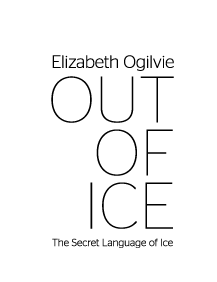Research in Greenland
For the last five years Elizabeth Ogilvie has made annual field trips to her research base in Ilulissat, North West Greenland to investigate the ice and water environments of the area, and to understand the Inuit relationship to ice. Her recent works have been directly informed by her experiences in Greenland resulting in installations using ice and ice melt constructions, and films about Inuit ice culture.
Ogilvie’s research informs works that aim to shed new light on the mechanics of the relationship between traditional culture, global warming and the political, economic and social change about to be wrought by mineral exploration and extraction in Greenland (and Alaska), and the human relationship with a natural world increasingly affected by industrialisation.
Sermeq Kujalleq glacier
Meaning ‘icebergs’ in Greenlandic, Ilulissat is a town located 250km north of the Arctic Circle at the mouth of a 56 km long ice fjord which is filled with enormous icebergs from Sermeq Kujalleq, the most productive glacier in the northern hemisphere.
Sermeq Kujalleq is one of the few glaciers through which the Greenland ice cap reaches the sea, and one of the fastest and most active glaciers in the world. The combination of huge ice sheet and fast moving glacial ice-stream calving into a fjord covered by icebergs is a phenomenon only seen in Greenland and Antarctica. The glacier has been the object of scientific attention for 250 years and, along with its relative accessibility, has significantly added to global understanding of ice-cap glaciology, climate change and related geomorphic processes. In 2004 it was admitted onto UNESCO’s World Heritage List.
The sea ice
The sea ice transforms not only the physical landscape around us but also the emotional landscape within us. We hear our sea ice language being spoken, our complex terminology for sea ice and its use. Along with the senses of sea ice come the stories, the journeys, and the memories. All the ice stories have their lessons and they are still important today.
SIKU: Knowing Our Ice: Documenting Inuit Sea Ice Knowledge and Use, 2010
Sea ice continues to be an integral component of Inuit daily life, being the basis for travelling and transportation, and for observing weather, tidal and current cycles, mammals and other life, and training in navigational and subsistence skills passed from elders to youth. For many communities, the use and knowledge of the ice-covered sea remains central to their identity and resilience, and their most prized intellectual treasure.
Elizabeth Ogilvie and the Inuit
Elizabeth Ogilvie has collaborated with Inuit based in and around Ilulissat, learning from their observed knowledge of changing ice conditions and deep connection to the landscape, to create films and other documentation with them. She has met Inuit explorers Karo Thomson Fleischer and One Fleischer who talked about their expeditions from their base in Ilulissat; David Storch Leed, a young student teacher and spokesman for the youth of Greenland who lives in a very remote community in Akuliarusinnguaq Bay (only reachable by boat, sledge or over sea ice); skipper and diver Jens Ole Thomassen; Nils Lange, a halibut fisherman and dogsled driver.
Using Inuit voices in the Out of Ice installation, Ogilvie hopes to introduce new audiences to fresh perspectives on the fundamental significance of our relationship to landscape.
 OUT OF ICE
OUT OF ICE









